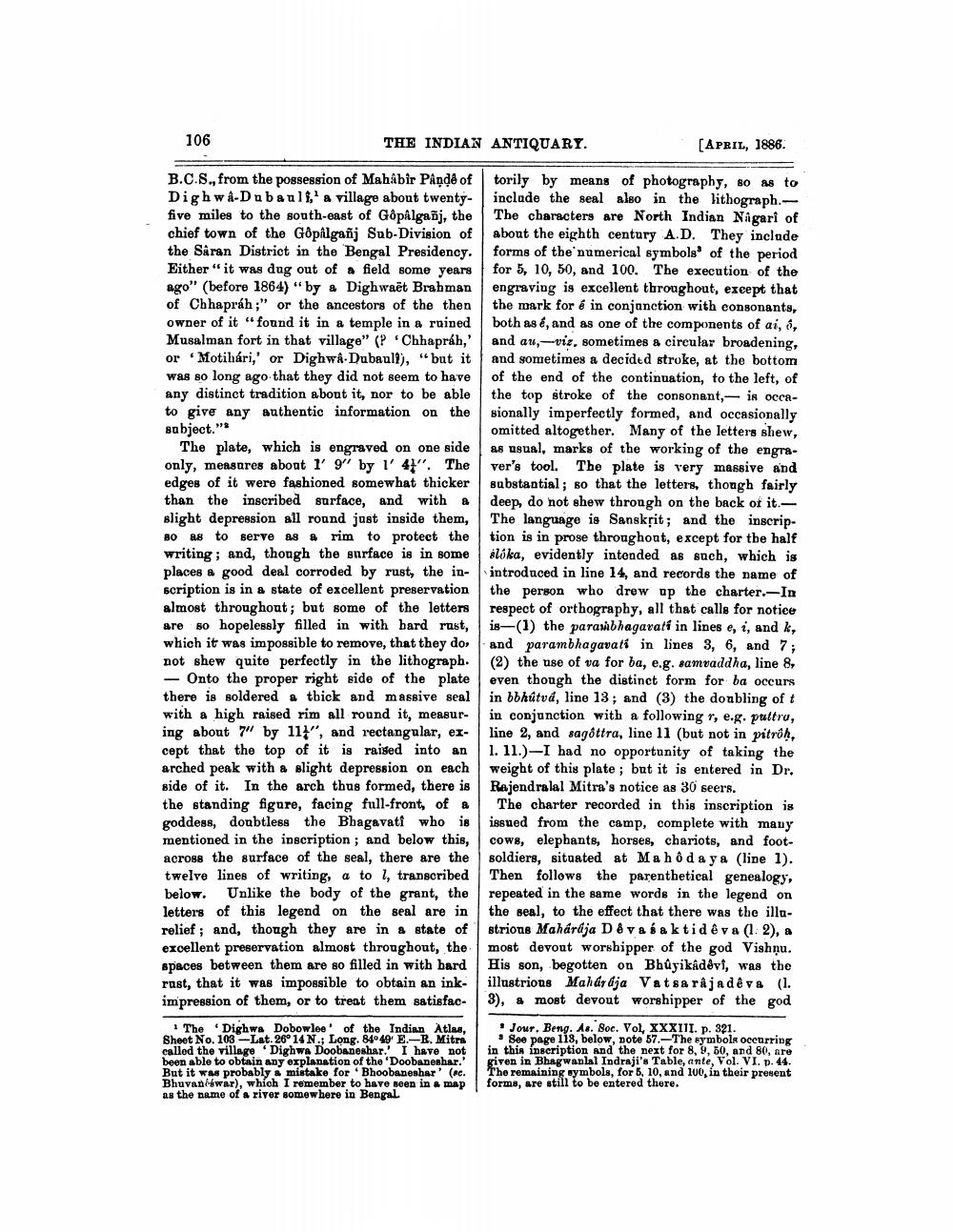________________
106
THE INDIAN ANTIQUARY.
[APRIL, 1886.
B.C.S., from the possession of Mahâbîr Pånde of torily by means of photography, so as to Dighwa-Dabault,' a village about twenty- include the seal also in the lithograph.five miles to the south-east of Gopalgaõj, the The characters are North Indian Nigari of chief town of the Gôpilgañj Sub-Division of about the eighth century A.D. They include the Saran District in the Bengal Presidency. forms of the numerical symbols of the period Either" it was dug out of a field some years for 5, 10, 50, and 100. The execution of the ago" (before 1864)" by a Dighwaet Brahman engraving is excellent throughout, except that of Chhapráh;" or the ancestors of the then the mark for & in conjonction with consonants, owner of it " found it in a temple in a ruined both as é, and as one of the components of ai, s, Musalman fort in that village" (P Chhapráh,' and au, --viz, sometimes a circular broadening, or Motihari,' or Dighwa-Dubauli), “but it and sometimes a decided stroke, at the bottom was so long ago that they did not seem to have of the end of the continuation, to the left, of any distinct tradition about it, nor to be able the top stroke of the consonant, in occato give any authentic information on the sionally imperfectly formed, and occasionally subject."
omitted altogether. Many of the letters shew, The plate, which is engraved on one side as usual, marks of the working of the engraonly, measures about l' 9" by 1'41". The ver's tool. The plate is very massive and edges of it were fashioned somewhat thicker substantial; so that the letters, though fairly than the inscribed surface, and with a deep, do not shew throngh on the back of it.slight depression all round just inside them, The language is Sanskrit; and the inscripBO as to serve as a rim to protect the tion is in prose throughout, except for the half writing; and, though the surface is in some slóka, evidently intended as such, which is places a good deal corroded by rust, the in- introduced in line 14, and records the name of scription is in a state of excellent preservation the person who drew up the charter.-In almost throughout; but some of the letters respect of orthography, all that calls for notice are so hopelessly filled in with hard rast, is-(1) the pararibhagavati in lines e, i, and k, which it was impossible to remove, that they do, and parambhagavati in lines 3, 6, and 7; not shew quite perfectly in the lithograph. (2) the use of va for ba, e.g. samvaddha, line 8,
- Onto the proper right side of the plate even though the distinct form for ba occurs there is soldered a thick and massive seal in bbhútvd, line 13; and (3) the doubling of t with a high raised rim all round it, measur- in conjunction with a following r, e.g. pultru, ing about 7" by 11+", and rectangular, ex- line 2, and sagôttra, line 11 (but not in pitrón, cept that the top of it is raised into an 1. 11.)-I had no opportunity of taking the arched peak with a slight depression on each weight of this plate; but it is entered in Dr. side of it. In the arch thus formed, there is Rajendralal Mitra's notice as 30 seers. the standing figure, facing full-front of a The charter recorded in this inscription is goddess, doubtless the Bhagavatf who is issued from the camp, complete with many mentioned in the inscription; and below this, cows, elephants, horses, chariots, and footacross the surface of the seal, there are the soldiers, situated at Mahôd a ya (line 1). twelve lines of writing, a to 1, transcribed Then follows the parenthetical genealogy, below. Unlike the body of the grant, the repeated in the same words in the legend on letters of this legend on the seal are in the seal, to the effect that there was the illurelief; and, though they are in & state of strious Mahárája D & va saktide va (1:2), a excellent preservation almost throughout, the most devout worshipper of the god Vishnu. spaces between them are so filled in with bard His son, begotten on Bhůyikadevi, was the rast, that it was impossible to obtain an ink- illustrious Maharaja Vatsarajadêva (1. impression of them, or to treat them satisfac- 3), a most devout worshipper of the god
The Dighwa Dobowlee' of the Indian Atlas, Jour. Beng. As. Soc. Vol. XXXIII. p. 321. Sheet No. 103-Lat. 26° 14 N.; Long. 84°49' E.-R. Mitra See page 118, below, pote 57.-The symbols occurring called the village Dighwa Doobaneshar. I have not in this inscription and the next for 8, 9, 50, and 80, are been able to obtain any explanation of the 'Doobaneshar.' given in Bhagwanlal Indraji's Table, ante, Vol. VI. p. 44. But it was probably a mistake for Bhoobanesher' (ec. The remaining symbols, for 5, 10, and 100, in their present Bhuvaneswar), which I remember to have seen in a map forms, are still to be entered there. as the name of a river somewhere in Bengal




